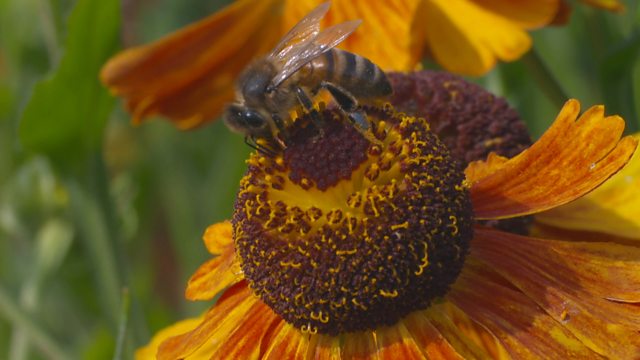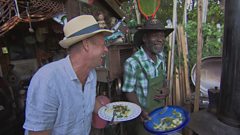Main content

Episode 22
Episode 22 of 31
Gardening magazine. Monty Don adds some late summer colour to his ornamental grass borders, while Carol Klein meets a man who is out to the find the best-performing heleniums.
As August draws to a close, Monty Don turns his attention to his ornamental grass borders. They are just coming into their prime but are in need of some late summer colour.
Carol Klein travels to Cheshire to meet a man who is on a mission to find the best-performing heleniums for British gardens.
Plus Joe Swift is treated to a Jamaican feast when he visits Moor Green allotments in Birmingham.
Last on
Thu 11 Sep 2014
10:05
Clips
-
![]()
Moor Green Allotments
Duration: 05:47
-
![]()
National Collection of Helenium
Duration: 06:00
Garden featured
Yew Tree House Garden
Hall Lane
Hankelow
�����ɱ���
Cheshire
CW3 0JB
Tel: 01270 811443
Martin Blow has been collecting and growing heleniums since the mid-90s and is on a mission to find the best performing varieties for our gardens. Here are his top ten recommendations:
��(�ɷɷ�.�Բ���.�ǰ���.�ܰ�)
Hall Lane
Hankelow
�����ɱ���
Cheshire
CW3 0JB
Tel: 01270 811443
Martin Blow has been collecting and growing heleniums since the mid-90s and is on a mission to find the best performing varieties for our gardens. Here are his top ten recommendations:
- Amber (150-180cm) Tall but self-supporting. A good mid-season show.
- The Bishop (45cm) A short one with yellow flowers. Very good for dry soils.
- El Dorado (80-90 cm) Golden flowers and does well in drier conditions.
- Indianersommer (120-140cm) A good tall variety with red flowers.
- Kanaria (120cm) An old, but reliable variety. Will stand some shade.
- Mardi Gras (60-75cm) Very early and long flowering in a blend of red, orange & yellow.
- Rauchtopas (120-140cm) Self-supporting with blooms that are apricot above & orange beneath.
- Red Army (65cm) The best of the short red ones and good in drier soils.
- Ruby Charm (90cm) A new variety with masses of red flowers on well-branched plants.
- Waltraut (75cm) Older variety with large orange/yellow flowers. Good for drier sites.
��(�ɷɷ�.�Բ���.�ǰ���.�ܰ�)
Taking Streptocarpus leaf cuttings

There is something rather special about creating new plants from ‘bits’ taken from other plants. Many plants have evolved a backup method to reproduce themselves vegetatively should seed production fail. With some plants, it is their stems, as hard and softwood cuttings. With others, it is the layering of stems. But with streptocarpus, and a small group of other plants, it is from leaf sections that new plants can be grown.
For the most part, the hormones responsible for shoot and root growth are concentrated in and around the leaf nodes and stem tips. But with streptocarpus, these hormones are also to be found throughout the plant’s leaves. Slicing along the midrib or across the leaf into many slices will produce new plants. Plants produced vegetatively in this way will always flower true to the mother plant. In other words, they are clones - a benefit if you have a favourite plant and want more.
��(�ɷɷ�.�����.�ǰ���.�ܰ�)
For the most part, the hormones responsible for shoot and root growth are concentrated in and around the leaf nodes and stem tips. But with streptocarpus, these hormones are also to be found throughout the plant’s leaves. Slicing along the midrib or across the leaf into many slices will produce new plants. Plants produced vegetatively in this way will always flower true to the mother plant. In other words, they are clones - a benefit if you have a favourite plant and want more.
��(�ɷɷ�.�����.�ǰ���.�ܰ�)
Allotment featured
Moor Green Allotments
Moor Green Lane
Birmingham
B13 8NL
Mobile: 07971 153938
If you would like to visit Moor Green Allotments, they will be holding their Annual Produce Show on Saturday 6 September and all are welcome. To find out more, follow the link below.
��(���Ǵǰ��������Բ������dzٳ���Գٲ�.����.�ܰ�)
Moor Green Lane
Birmingham
B13 8NL
Mobile: 07971 153938
If you would like to visit Moor Green Allotments, they will be holding their Annual Produce Show on Saturday 6 September and all are welcome. To find out more, follow the link below.
��(���Ǵǰ��������Բ������dzٳ���Գٲ�.����.�ܰ�)
Figs

A plump, ripe fig picked fresh from the tree is a true late summer delight. Its taste encapsulates all that is good of the season.
Figs like a long, hot summer to succeed and Monty’s tree, a ‘Brown Turkey’, is the best variety to grow outside in this country. If, like Monty, your fig is cropping well, try eating them fresh with cheese or roasted - a treat indeed!
��(�ɷɷ�.������.����.�ܰ�/�ڴǴǻ�)
Figs like a long, hot summer to succeed and Monty’s tree, a ‘Brown Turkey’, is the best variety to grow outside in this country. If, like Monty, your fig is cropping well, try eating them fresh with cheese or roasted - a treat indeed!
��(�ɷɷ�.������.����.�ܰ�/�ڴǴǻ�)
Jobs for the weekend: Sow hardy annuals
An autumn sowing of hardy annuals will bring early rewards for next season. Usually hardy annuals are sown in spring for mid to late summer colour, but because hardy annuals are tough, seeds sown in early autumn have a good chance of turning into young plants before the winter sets in. Come the spring, plants will move quickly into growth and bloom early.
Monty sowed Calendula but there are lots of others to try. Examples include cornflower and love-in- a-mist. Seed can be sown directly into a prepared bed in a border or straight into a favourite pot.
��(�ɷɷ�.�����.�ǰ���.�ܰ�)
Monty sowed Calendula but there are lots of others to try. Examples include cornflower and love-in- a-mist. Seed can be sown directly into a prepared bed in a border or straight into a favourite pot.
��(�ɷɷ�.�����.�ǰ���.�ܰ�)
Jobs for the weekend: Cut free rooted strawberry runners
Strawberries are the fruit of early summer; sadly this season is now over. If earlier, like Monty, you pegged down runners, now is a good time to check to see if they have rooted. If pegged into the surrounding soil, remove the pegs and give the plant a little tug. If there is resistance, they are ready to be lifted. But if you pegged them into a pot, turn the pot over and gently knock the plant out. With luck, new roots should be visible.
Once cut free from the mother plant, new plants can be transferred to a new bed or grown on in their pots. This method of propagation is a good way to maintain a healthy stock and increase plant numbers for several strawberry seasons to come.
��(�ɷɷ�.�����.�ǰ���.�ܰ�)
Once cut free from the mother plant, new plants can be transferred to a new bed or grown on in their pots. This method of propagation is a good way to maintain a healthy stock and increase plant numbers for several strawberry seasons to come.
��(�ɷɷ�.�����.�ǰ���.�ܰ�)
Jobs for the weekend: Harvest chillies and peppers
Sweet peppers and chillies should now be turning red. Don’t be tempted to leave them on the plant just because they look good. Ripe fruit left hanging prevents new flowers from forming, and by picking these fruits, it will encourage those that are green to ripen. Harvesting ripe fruits will extend your cropping season through into late autumn.
��(�ɷɷ�.�����.�ǰ���.�ܰ�)
��(�ɷɷ�.�����.�ǰ���.�ܰ�)
Credits
| Role | Contributor |
|---|---|
| Presenter | Monty Don |
| Presenter | Carol Klein |
| Presenter | Joe Swift |
| Series Producer | Christina Nutter |
| Series Editor | Liz Rumbold |
Broadcasts
- Fri 29 Aug 2014 21:30
- Sun 31 Aug 2014 08:00
- Thu 11 Sep 2014 10:05


